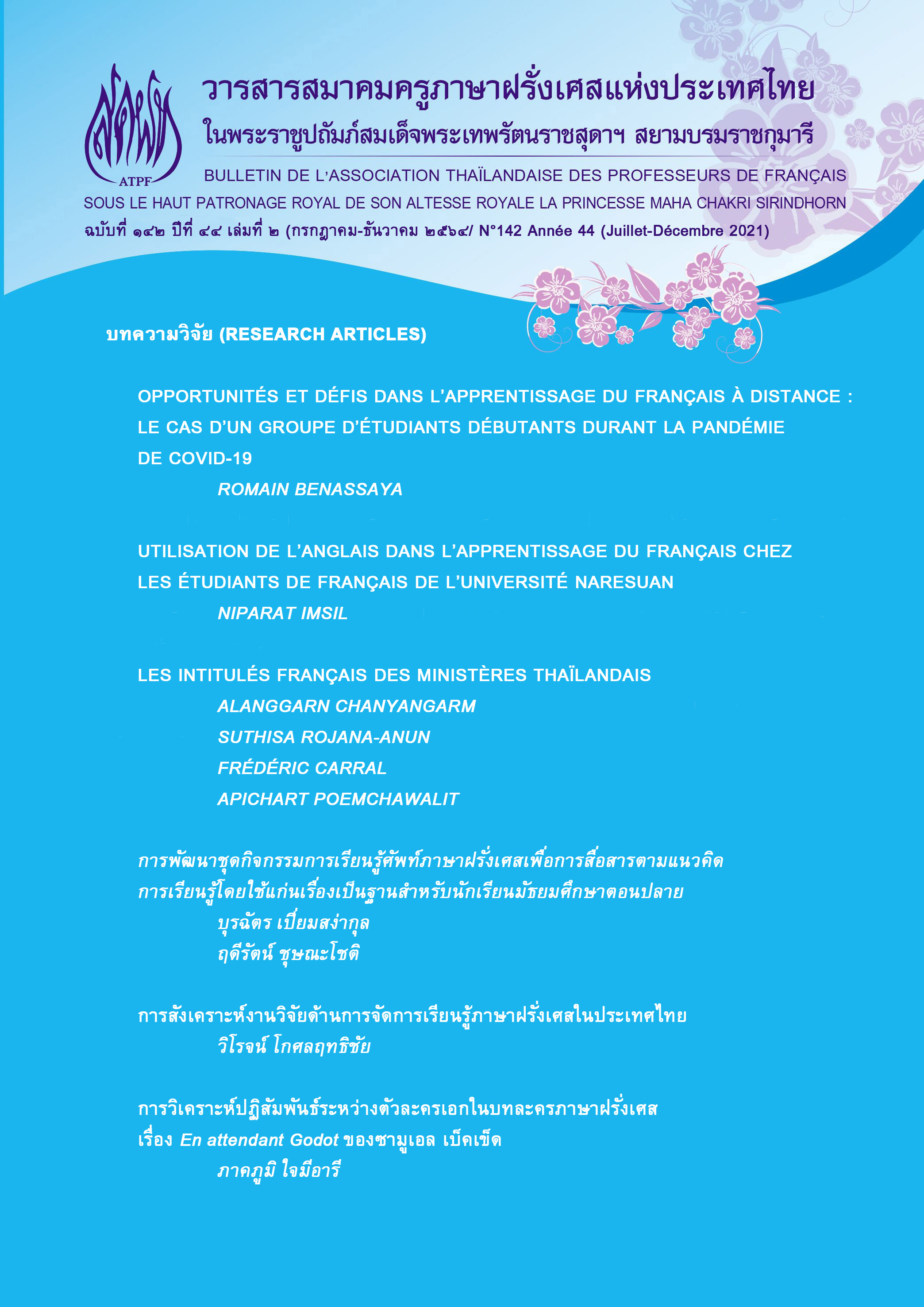การวิเคราะห์ปฏิสัมพันธ์ระหว่างตัวละครเอกในบทละครภาษาฝรั่งเศสเรื่อง En attendant Godot ของซามูเอล เบ็คเข็ด
Main Article Content
บทคัดย่อ
งานวิจัยชิ้นนี้มีจุดประสงค์วิเคราะห์ปฏิสัมพันธ์ระหว่างตัวละครเอกในบทละครเรื่อง En attendant Godot ของ Samuel Beckett โดยนำทฤษฎีการวิเคราะห์บทสนทนาและวาทกรรมวิเคราะห์มาประยุกต์ใช้ งานวิจัยชิ้นนี้จึงไม่ได้มุ่งเน้นการวิเคราะห์ปฏิสัมพันธ์ระหว่างตัวละครในเชิงวรรณกรรม ผลการวิจัยพบว่าลักษณะการใช้ภาษาในบทสนทนาของตัวละครเอกมี 8 ประเภท คือ การพูดตะกุกตะกัก การพูดซ้ำไปซ้ำมา การพูดผิดไวยากรณ์ การพูดคำหยาบ การพูดขัดจังหวะ การใช้ภาษาที่ไม่สัมพันธ์กับการกระทำ การใช้คำที่มีความหมายเหมือน และการใช้ประโยคคำสั่ง ลักษณะการใช้ภาษาของตัวละครยังสะท้อนให้เห็นถึงสภาพอารมณ์และจิตใจที่มีความวิตกกังวล ไม่มั่นใจกับสิ่งที่ยังมาไม่ถึง
ผลการวิจัยยังพบอีกว่า หากปฏิสัมพันธ์ในชีวิตประจำวันจะเกิดขึ้นได้ต้องมีจุดประสงค์ในการสื่อสาร คู่สนทนาต้องมีเป้าหมายที่ต้องการจะสื่อสารความต้องการของตนเอง ปฏิสัมพันธ์ระหว่างตัวละครเอกในบทละครเรื่องนี้กลับเกิดขึ้นจากการพูดคุยและการกระทำที่ไม่มีสาระแก่นสาร ในระหว่างที่ตัวละครเอกรอ Godot ตัวละครเอกสื่อสารระหว่างกันเพียงเพื่อใช้ฆ่าเวลาและกำจัดความเงียบเท่านั้น การสนทนาระหว่างกันไม่มีจุดประสงค์ของการสื่อสารที่แน่วแน่และชัดเจน คำพูดและการกระทำของตัวละครเอกนำไปสู่สิ่งที่เรียกว่า “ความแปลกวิสัย” ของการสื่อสาร ปฏิสัมพันธ์ระหว่างตัวละครเอกในบทละครเรื่อง En attendant Godot ของ Samuel Beckett จึงเป็นการสื่อสารที่ไม่สัมฤทธิ์ผล
Downloads
Article Details
เอกสารอ้างอิง
พจนานุกรมฉบับราชบัณฑิตยสถาน พ.ศ. 2542. กรุงเทพมหานคร: นานมีบุ๊คส์
Austin, J.L. (1962). How to do things with words. Oxford: Charendon Press..
Beckett, S. (1952). En attendant Godot. Paris: Editions de Minuit.
Darcos, X. (1992). Histoire de la littérature française. Paris: Hachette.
Disson, A. (1996). Pour une approche communicative dans l’enseignement du français au Japon : Bilan et Propositions. Osaka: Presse universitaire d’Osaka.
Dubois, J. et al. (2001). Dictionnaire de Linguistique. Paris: Larousse.
Esslin, M. (1961). The Theatre of the Absurd. London: Bloomsbury Publishing.
Lecherbonnier, L. et al. (1989). Littérature du XXe siècle. Paris: Nathan.
Kerbrat-Orecchioni, C. (1990). Les interactions verbales 1. Paris: Armand Colin.
Moirand, S. (1982). Enseigner à communiquer en langue étrangère. Paris: Hachette.
Rey-Debove, J. et Rey, R. (2000). Le Petit Robert. Paris: Robert.
Ryngaert, J.P. (1991). Introduction à l’analyse du théâtre. Paris: Bordas.
Sacks, H. (1984). “On doing “being ordinary” in Handbook of Discourse Analysis, S.D. pp. 13-23.
Sacks, H., Schegloff, E. & Jefferson, G. (1974). “A Simplest Systematics for the Organization Of Turn-Taking in Conversation” in Langage, 50, 695-735.
Traverso, V. (2004). L’analyse des conversations. Paris: Nathan.
Ubersfeld, A. (1996). Lire le théâtre. Paris: Editions Belin.


